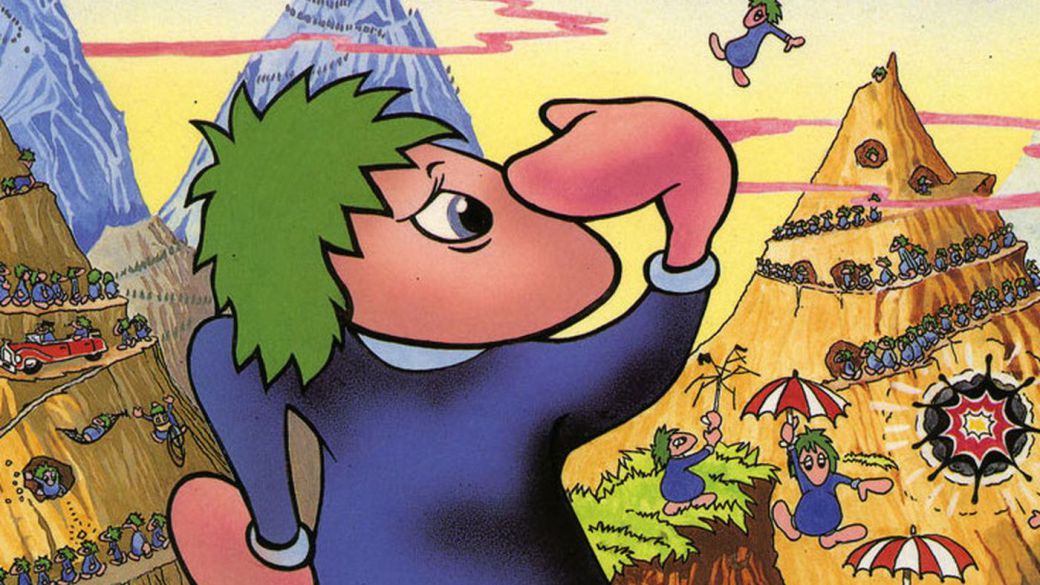
Before GTA and Rocksat, there was “just” DMA Design and a game that catapulted the Scottish studio to stardom.
In 1958, Disney released a nature documentary called White Wilderness that would end up taking an Oscar from the academy. One of the most impressive moments of the film was a sequence in which a strange phenomenon was narrated in the behavior of an animal called lemming, a small rodent native to arctic areas. As it was narrated, when the population was too large a part of them chose to jump into the sea as a form of mass suicide, aiming at a sacrifice in pursuit of the preservation of the group as part of the mysterious behavior. Accompanied by spectacular shots of the rodents falling, orchestrated music and the ominous voice of Winston Hibler, a whole generation of children and adults was left with that idea in their heads, assuming it as one more sinister peculiarity of Mother Nature. Too bad it was all a lie and that the authors of the film were the ones who threw the animals off the cliff. Quite a stain for the “House of the Mouse” (and no, you won’t find the documentary on Disney Plus, for obvious reasons).
It is a shame that the game we celebrate is inspired (unintentionally) by such an aberration, but that will not prevent us from celebrating 30 years since the launch of Lemmings, one of the most iconic games in the original Amiga catalog and an international success that reached a multitude systems as well as being the foundation stone for various continuations that span the decades. In addition, it was the project that put on the map and allowed to expand to a small Scottish studio called DMA Design, which years later would launch a small game, which may sound like you, called Grand Theft Auto in addition to changing its name to Rockstar North, although that’s another history.
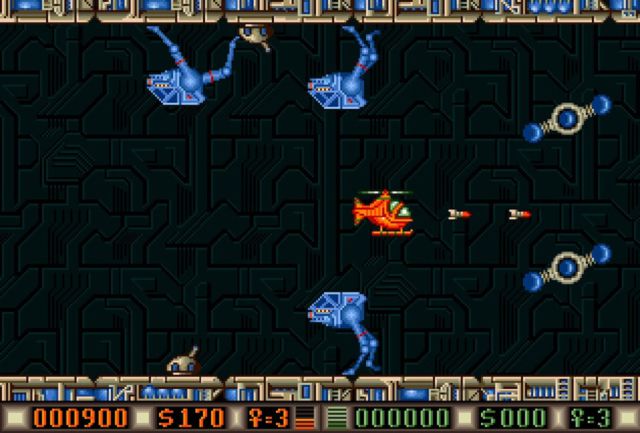
Blood Money walkers were the seed of Lemmings
DMA Design’s first big success
It would be on February 14, 1991 when DMA’s new work landed on the British market under the label of the then powerful Psygnosis. After settling down with some minor but striking works such as the shoot’em up Blood Money, in which signs of technical brilliance could be seen such as the fabulous introduction, the small Scottish studio launched in Amiga what would be the game that would definitely catapult him into fame, a dynamic puzzle title that conquered the market with its originality, inventiveness and sympathy, armed with the irresistible personality of its protagonists: dozens of friendly little green men who marched in a straight line and who had to be guided so that they could reach home safe and sound. While it is true that Lemmings do not “commit suicide”, it is true that when the population is very large a fraction of them seek new areas and sometimes they die in large numbers when they cross rivers through dangerous areas, following the few the others. The idea of being an invisible hand that guides the creatures is the one that feeds the approach of the original game, something novelly kind in a panorama of the video game in which the priority was to annihilate the enemy.
Although to be fair, the original spark of development was not in saving, that would come later. DMA Design was a small team formed then by Mike Dailly, Dave Jones, Russell Kay and Steve Hammond, who formed a study as the studies were formed at that time in the United Kingdom: being friends or classmates and learning to program by emulating others games until they got something that interested a house to distribute and trade, a key moment that separated the hobby from professionalization. DMA was already in the process of professionalization: their jobs, both Menace and Blood Money had sold reasonably well (around 10,000 and 20,000 units respectively, decent numbers) and they already had a relationship with an established house like Psygnosis. They could already afford to rent an office, have contracts and establish themselves as a real studio, although they had no suspicions about the size of their next job.
It all started with an enemy from Blood Money, a space shoot’em up partially inspired by Irem’s Mr Heli. One of the enemies, named Walker, was a kind of jumping earth meka, inspired a bit by models of bipedal machines like the AT-ST from Star Wars or the ED 209 from Robocop. The early DMA games displayed great technical and visual talent, and that particular enemy was especially well animated, with fluid steps that attracted attention. Those responsible saw potential to do more and began various experiments to reduce the size and see how the animation of walking was preserved in those circumstances. Once they found a tiny and expressive humanoid sprite, they multiplied the number of them by walking in a straight line as a technical proof of concept. And, for fun, they created various traps to annihilate them in the most comical way possible; devoured by a clown face, thrown into the void at full speed, crushed by a weight … It was simple fun and experimentation, but Russell Kay was the first to see that there was a game there.
100 Lemmings on display
Although the face hook was in the eye of seeing up to 100 of those creatures walking in unison across the stage and the comical ways in which they could die, the truth is that the design soon morphed into what would be the final game. How could 100 of these creatures be controlled? not doing it directly, how could the idea of cheating be used? as key points for designing puzzles. Once the idea of the “Lemmings” was thought about, marching in a straight line even if it was to the death, everything evolved organically and the basic idea that would feed the whole design was quickly found. The player would not control directly, but would have the limited ability to assign roles to a certain Lemming using the mouse. We could make you dig or dig a hole in a wall, build bridges, grab an umbrella that would allow you to float if you fell too high. Through these roles we were able to ensure that the herd was safe at its destination.
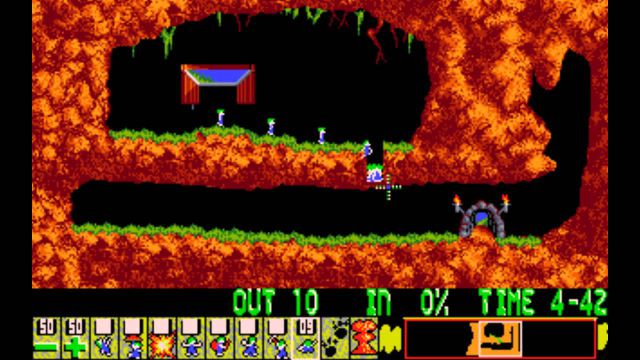
The first bars of the Lemmings’ adventure
As good and original as the idea and basic mechanics were, it would be wasted without a good design of scenarios and puzzles. Fortunately, the team did a superb job in that regard as well. The game was a full year of development, a lot for the time but more than well used, allowing a long and well adjusted difficulty curve that went from learning without realizing it to “how the hell do I complete this phase?”. Although we only had eight types of roles for our Lemmings, each phase managed to offer us different challenges, with different designs. Sometimes we needed to coordinate roles at different points, other times we had to get the herd to safety while a lemming paved the way for the others to get home. Each level required a minimum number of Lemmings to save, very loose at the beginning but extremely tight at the end.
An example of the will to create a challenge was in the figure of the “stoppers”, some Lemmings that acted as a retaining wall for the others. Once they were assigned that role, they stayed put forever and we couldn’t save them anymore, so once everyone else was safe there was only the option to blow them up (that was also the spectacular way we reset a level when we got stuck). But once we progressed through the phases we found that we were also required to save them and that was the moment when, through sheer experimentation, we found that the only possibility of restoring them to their normal state was to excavate just at the right time to eliminate the ground under their feet and cause them to fall, at which point they regained mobility. There were discussions on the team about whether it wouldn’t be easier to just make the player restore them with a function, but Mike Dailly didn’t want it to be a trivial game. That “advanced movement”, precise and difficult to execute is one of the keys to the difficulty of the final levels and what gives the set its satisfactory conclusion. The inclusion in addition of a two-player mode, with 20 phases enabled to be played with a double mouse, completed an essential set.
An immortal design
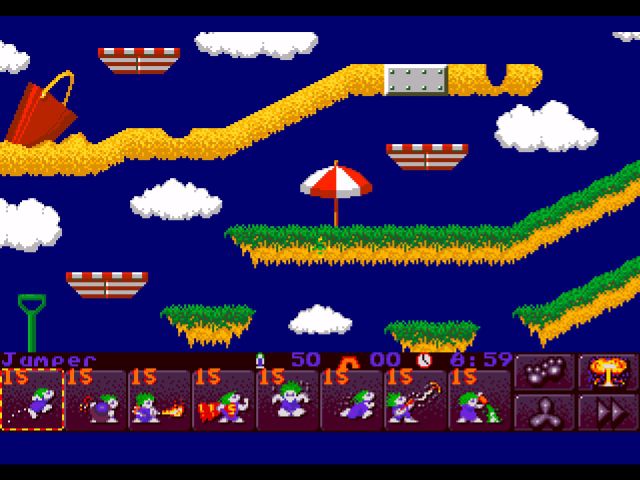
Lemmings 2 expanded the list of roles
The originality and design of the game is joined by an unforgettable soundtrack composed of digitized classic themes, which gave it a very particular air. Originally there was an idea to use more modern themes, such as the A-Team title song or the Batman series, but Psygnosis soon realized the problems that could cause and commissioned the legendary Tim Wright to use themes for the that they couldn’t sue them. The set was simply a special game, round and different, which garnered very high marks in the magazine of the time. 50,000 copies were sold in a single day, quite a hit, and without wasting a moment numerous conversions were launched that made the game land on all kinds of systems and computers of the time (more than twenty, including more exotic systems such as the SAM Coupé, the CD-I or the Sharp X68000). In total, it would go on to sell more than 15 million copies worldwide, placing it as one of the greatest hits of the time.
Of course, in addition to conversions, success would motivate sequels and expansions. Two short games with Christmas motifs were released, Christmas Lemmings, and an expansion of the original called Oh No! More Lemmings. It would receive a proper sequel in 1993 with The Tribes, a technically brilliant game that expanded all the possibilities of the original (although for the taste of some, including a part of its own creators, it expanded them too much, providing an excess of roles that ended by take away the elegance of the whole). By the third part, All New World of Lemmings, in DMA they were already exhausted of their own work and upset by some obligations that they saw unnecessary as increasing the size and detail of the Lemmings. They only finished it to end the contractual agreement with Psygnosis and be able to focus on other projects, which was noticeable in its lower quality compared to previous ones. From Pysgnosis, already without DMA, they tried to resurrect the flame with two spinoffs (Lemmings Paintball and The Adventures of Lomax) and two polygonal deliveries: 3D Lemmings and Lemmings Revolution, although with little success. As part of the purchase of the British label, the rights passed to Sony, which has also not made any great attempts to relaunch the brand, although at least it allowed Team 17 to make a rather nice remake in 2006 for PSP, PS2 and PS3, with an exquisite soundtrack by another musical genius, Tim Follin.
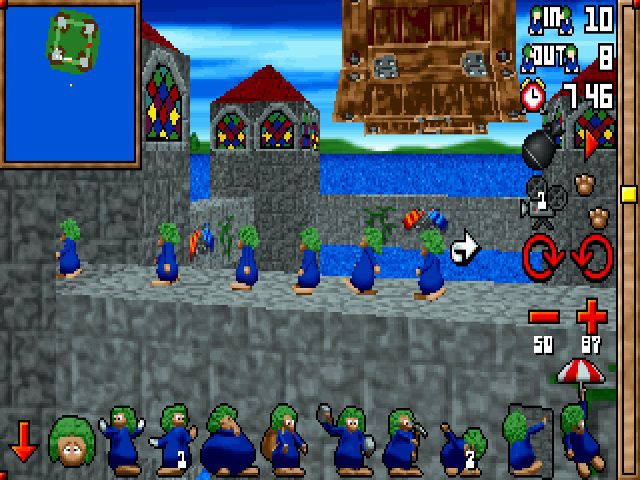
3D Lemmings tried to bring the formula to polygons, without success
The Lemmings legacy dissipates over the decades in the absence of strong new sequels, although perhaps it is better that way. No installment has managed to match the first in terms of design and balance, remaining in a special and unique place in the history of the video game, a title from its time and a flag within the heterogeneous Amiga catalog, full of unique and different titles, with novel and experimental mechanics that offered a vivid contrast to what we saw on consoles and arcades. Its legacy has not been clearly continued, nor has it been successfully evolved with its aftermath, but its memory remains with all who enjoyed it and all who will enjoy it through conservation. Because if anything can be said about Lemmings on this 30th anniversary, it is that it has aged like fine wine and remains as brilliant now as it was in its time and as it will continue to be for another thirty years.

